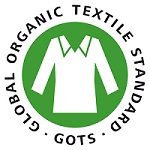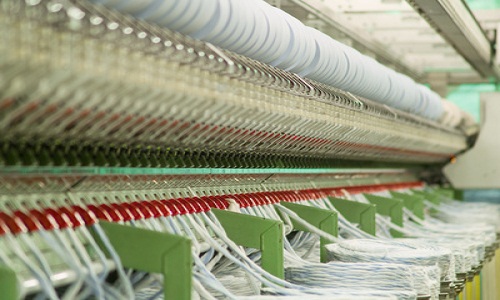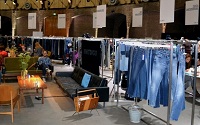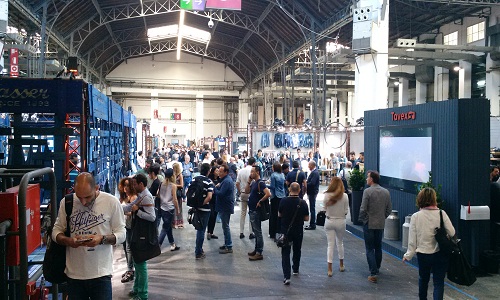FW
The readymade garment industry in Bangladesh will have to focus on three key elements: positive promotion of branding, technological capability and interest of economy, say experts. There was a shortage of capacity in the readymade garment industry but now the situation has changed as there are technologies available. At present the country has only a six per cent share of the global market in readymade garments. It is looking to have a bigger share. Machinery and technology have to be modernized.
Since online selling and buying has increased in the global market, 96 per cent of the goods being bought are being bought at a discount or bought with different offers. As a result, buyers are unwilling to pay more to suppliers. With the recent fluctuation of different currencies, the country has to take measures to keep the value of its currency stable.
Spain has a much higher cost of labor than does Bangladesh but has still managed through the use of technology to be competitive in the clothing industry. Similarly Italy and Mexico use technology to reduce the cost of production of their products. Bangladesh has a goal of doing $50 billion in readymade garment exports by 2021.
Bangladesh Denim Expo will be held from May 17 to 18, 2017 in Dhaka. The theme for the expo is ‘Denim Networks’ and will highlight the importance of developing understanding and relationships in the denim industry. The aim is to connect experts, brands, retailers and the industry’s top players in order to share a global approach toward the main challenges.
Exhibitors from 12 countries -- Bangladesh, China, India, Turkey, Spain, Italy, Pakistan, Japan, San Marino, Germany, Brazil and Hong Kong -- are expected to take part. The trend zone area, the unique space dedicated to showcase latest denim trends and innovative products, has been expanded in parallel, incorporating a new information exchange zone where visitors will be able to gain insights into denim fabrics, styling and finishing available in Bangladesh, together with a select offer of the most relevant denim publications. Bangladesh Denim Expo has been conceived of as an international strategic hub to attract the most interesting and innovative denim-related projects.
"India continued to maintain top position in a row with 1,488 GOTS certified facilities. GOTS is also a part of the QCI-UNFSS India National Platform on Private Sustainability Standards, launched in 2016 by the Ministry of Commerce. GOTS representative in India Sumit Gupta is a member of the textile subcommittee in this platform. Interest in GOTS certified organic textile products is on the rise in India both among consumers and industry. India also recorded a rise in the number of brands and stores selling GOTS certified textiles."

India continued to maintain top position in a row with 1,488 GOTS certified facilities. GOTS is also a part of the QCI-UNFSS India National Platform on Private Sustainability Standards, launched in 2016 by the Ministry of Commerce. GOTS representative in India Sumit Gupta is a member of the textile subcommittee in this platform. Interest in GOTS certified organic textile products is on the rise in India both among consumers and industry. India also recorded a rise in the number of brands and stores selling GOTS certified textiles. Closer home, Bangladesh maintained fourth position with 331 facilities. In fact, Dhaka hosted a successful national seminar on GOTS Certification in November 2016, which was attended by 170 people from five countries.
Increasing organic growth

The number of GOTS certified facilities went up from 3,814 facilities in 2015 to 4,642 facilities in 2016. These are spread across 63 countries around the world. Growth is continuously is evenly spread across all market segments including the mass market and big brands. GOTS certification covers the processing of organic fibers along the entire supply chain from field to finished products.
Countries or regions with the largest increase in GOTS certification in 2016 are: Bangladesh on top with +121 units; China (+68), Italy (+54), Germany (+41), India (+47) and Pakistan (+30). The top three countries based on total number of certified entities were: India (1,488), Turkey (423), Germany (347). “The significant growth in numbers of GOTS certified facilities shows the willingness of more and more decision makers not only to drive change by complying with the strict GOTS criteria but also to prove this change by undergoing an independent third party certification,” says Herbert Ladwig, MD, GOTS. To date, the 18 GOTS accredited independent Certification Bodies report more than 1.4 million people in 4,354 (out of the actual 4,642) working in GOTS certified facilities.
For GOTS, 2016 was a revision year resulting in the release of GOTS Version 5.0 on March 1, 2017. The key changes in brief: The use of Viscose and Modal (additional fibre content) is now restricted to 10 per cent (25 per cent for sportswear and socks). Lyocell fibre made from certified organic or FSC sources may still be used up to 30 per cent because of its sustainable manufacturing processes. For the first time, GOTS will allow ‘Combined Products’ such as prams with textile fabrics, bassinets, car seats or furniture with textile fabric upholstery to have certified and labelled textile components. As for GOTS social criteria, an explicit section on Ethical Business Behaviour including a corruption ban was added, based on UN Global Compact Principles. The mandatory GOTS Social Compliance Management System for the first time includes guidance on the use of tools such as SAI Social FingerprintTM to help companies measure and improve their social performance.
The Alliance for Bangladesh Worker Safety has during March-April, 10 more Alliance-affiliated RMG factories completed all material components outlined in their Corrective Action Plans (CAPs). This pushes up the total number of factories that have completed CAPs has now risen to 76.
Alliance country director Jim Moriarty says these companies have made commitment towards worker safety by completing their corrective action plans. Their focus on remediation reflects the broader push that has transformed safety in Bangladesh’s RMG industry and directly translated into lives saved. Meanwhile, the Alliance continues to enforce accountability measures for factories that fail to prioritise remediation. In March and April, it suspended nine factories from the Alliance compliant factory list, bringing the total number of suspended factories to 146.
The Alliance was formed by North American retailers including Walmart and Gap after the Rana Plaza building collapse in April, 2013, that killed more than 1,100 people, mostly garments workers. Under a five-year plan, the Alliance has set timeframes and accountability for inspections and training and workers empowerment programmes.
A conference on innovative and water efficient processes in the textile sector will be held in New Delhi on May 18, 2017. The conference is being organised with a view to create awareness to deal with the challenges with regard to new regulations and guidelines and learn about increasingly advanced treatment technologies, innovative strategies geared towards water and wastewater reuse and resource recovery.
The conference will be attended by prominent stakeholders from the textile industry, relevant authorities from the Central and State Pollution Control Boards and other experts to deliberate upon the challenges being faced by the sector and showcase national and international best practices from progressive and futuristic companies.
The Central Ground Water Authority and the National Green Tribunal have issued directions to ensure that all existing, new and expansion industries or projects extracting ground water should obtain permission from the Central Ground Water authority.
The textile industry has a strong impact on climate. Water is used extensively throughout textile processing operations. There is an urgent need for making efforts toward reducing the use of fresh water in various processes and making use of technologies that treat and reuse process water as well as treated wastewater. The event is being organized by the Confederation of Indian Industry (CITI).
A Youth Fashion Summit will take place in Denmark from May 9 to 10, 2017. This will attract students from around the world. Young talents will engage in discussions about the industry they will soon inherit and how to address the major problems of fashion manufacturing and consumption. They will draft and negotiate the first-ever United Nations resolution on fashion.
The resolution will be negotiated with industry leaders such as H&M and Swarovski and NGOs such as Greenpeace before being presented on stage at Copenhagen Fashion Summit on May 11. Later this year, the resolution will be presented to the UN in New York. The Youth Fashion Summit is a collaboration between Global Fashion Agenda and the Copenhagen School of Design and Technology in partnership with Swarovski.
At last year's Youth Fashion Summit, students explored how the 17 UN Sustainable Development Goals represent opportunities for companies to align their sustainability goals with broader societal aims: from gender equality and poverty reduction to responsible consumption and climate action.
Educators and fashion education leaders will meet prior to Copenhagen Fashion Summit for their respective events, Educators Summit and Academic Leaders Roundtable. While Educators Summit is a platform for teachers to exchange ideas and experiences on how to effectively teach sustainability and build a strong international network around it, Academic Leaders Roundtable convenes the most influential decision-makers from across fashion education, industry and non-governmental organizations for an intimate discussion informing the development of sustainability in global fashion.
Bangladesh Denim Expo will be held from May 17 to 18, 2017 in Dhaka. The theme for the expo is ‘Denim Networks’ and will highlight the importance of developing understanding and relationships in the denim industry. The aim is to connect experts, brands, retailers and the industry’s top players in order to share a global approach toward the main challenges.
Exhibitors from 12 countries -- Bangladesh, China, India, Turkey, Spain, Italy, Pakistan, Japan, San Marino, Germany, Brazil and Hong Kong -- are expected to take part. The trend zone area, the unique space dedicated to showcase latest denim trends and innovative products, has been expanded in parallel, incorporating a new information exchange zone where visitors will be able to gain insights into denim fabrics, styling and finishing available in Bangladesh, together with a select offer of the most relevant denim publications. Bangladesh Denim Expo has been conceived of as an international strategic hub to attract the most interesting and innovative denim-related projects.
Caldera is showcasing its updated textile production platform, Textile Pro, at Fespa, Germany, May 8 to 12, 2017. Textile Pro reflects Caldera’s long history of partnerships within the world of digital printing onto fabric, providing intuitive workflow control for both decorative and industrial textile printing.
Textile Pro ensures colors are repeated faithfully by providing RGB (red green blue) workflow throughout pre-press and imposition, while patternation and media variances are handled effortlessly within the interface. Supporting all major textile printer manufacturers and with partnerships, Caldera is witnessing rapid adoption in this evolving market.
Caldera V11 was released to celebrate the company’s 25th anniversary last year, and 2017 now sees the advent of V11.1. This update introduces the ability to define custom media sizes within the print interface without needing to configure new media in the server administration.
For ultra-connected printers, such as the HP Latex range, this enables Caldera to recognise the media type and size when loaded on the engine. It also sees the introduction of exponential linearization targets in Easy Media to improve color calibration and stability. Further improvements to popular modules include additional functionality in Print Bleed and enhanced savings in Ink Performer.
"The push and pull between rigid and stretch, authentic and performance, and fast and handcrafted played out at Kingpins Amsterdam and Denim Première Vision, where a global blend of mills, trim suppliers and other elements of the denim supply chain came together to present their Autumn/Winter 2018-2019 collections and innovations. Anchoring each of these themes was a heightened awareness for sustainability as mills debuted new efforts to save water, reduce chemicals and increase the use of sustainable fibres like Tencel, BCI cotton, recycled polyester and other post-consumer fibres."

The push and pull between rigid and stretch, authentic and performance, and fast and handcrafted played out at Kingpins Amsterdam and Denim Première Vision, where a global blend of mills, trim suppliers and other elements of the denim supply chain came together to present their Autumn/Winter 2018-2019 collections and innovations. Anchoring each of these themes was a heightened awareness for sustainability as mills debuted new efforts to save water, reduce chemicals and increase the use of sustainable fibres like Tencel, BCI cotton, recycled polyester and other post-consumer fibres.

For most mills at the shows, sustainability began with new techniques that save water, and ultimately money. In fact, Denim Première Vision’s fashion team called water-less technology as a key theme in its Autumn/Winter 18-19 Denim Tastings seminar, pointing out that these innovations are creating new design possibilities.
Greening growth pastures
At Denim Première Vision, Mexico-based mill Global Denim touted its Ecoljean technology. While a regular pair of jeans passes through six washes and takes an average of 20 litres of water to produce, Ecoljean process requires no water discharging, less energy consumption, less dye consumption and creates a smaller CO2 footprint. The result is an efficient product with less colour variation and a better wash down effect.
In Amsterdam, where the cost of sustainability was a hot topic during Kingpins Transformers, Garmon Chemicals rolled out Geopower NPS, the company’s newest effort to establish strong and effective R&D that sets a new standard for sustainable practices. Short for ‘no pumice stone,’ the new technology achieves rich heritage looks on denim and creates a range of stonewash effects, panel and seam abrasion, high color loss and contrasts. The technology, which has already been implemented by denim brand Only’s R&D program, produces zero pumice sludge and radically cuts environmental impact (especially water) and costs.
Kassim introduced denim that helps clean air pollution. The mill collaborated with an Italian research partner to produce Photocatalytic Denim containing photocatalytic nano composites to eliminate pollutants by using just natural sunlight. Kassim also teamed up with Bainisha, a biomedical product development company, to create denim for professional athletes. Garments are equipped with sensors that send data about the wearer’s posture and gait to an app accessible on their phone.
Fashion & functionality at its best
At Kingpins Amsterdam, Artistic Milliners and its Dubai-based garment and finishing innovation lab, presented denim made with the mission to make each step as sustainable and traceable as possible, from thread to rivet. The end product was a jean made with organic cotton, recycled cotton, recycled polyester and Lycra, finessed with sustainable rivets and sustainable leather back patch.
Denim’s reliance on sustainable and performance fibres was evident at both European shows. Going into the new season, Denim Première Vision’s trend team said BCI cotton is the most frequent proposal, followed by organic cotton and recycled polyester. Meanwhile, mills turned to fibres from Invista and Lenzing to create stretch and authentic looks that satisfy the market’s demand for recovery, softness and durability. US Denim partnered with Invista to create SelvedgeX, a range authentic selvedge with built-in comfort and performance. The denim is made with a collection of antique selvedge looms, incorporating Lycra XFit technology for freedom of movement, controlled shrinkage and shape recovery.
Innovations galore
Artistic Milliners Garments and Finishing used Tencel and Lenzing Modal as a springboard for its new PP-free ‘sustainable softness’ Haptic collection. The eco fabrics, designed to offer softness, moisture management and breathability, combines laser technology and other treatments to achieve a localized effect. For instance, ozone technology enhances Haptic’s sanitizing and disinfecting properties, while Jeanologia’s E-flow technology creates high and low effects. Inspired by the Nordic ‘hygee’ movement—a trend based on cozy and comfortable living—Artistic Milliners presented Sunday Jeans. The fabrications incorporate Tencel, Lenzing Modal and fiber dyed modal for a soft look and feel. The fabric is suitable alternative to leggings for mellow weekends.
Soorty sees demand for more application of denim in the activewear market. The mill rolled out Denim Active, a bi-stretch Tencel and organic cotton concept based on second skin silhouettes. The collection, offered in three variants, delivers an index of performance qualities, including freedom of movement, quick dry, soft touch and moisture management. A version with Coolmax All Season is designed to keep the wearer cool and dry on hot days and warm on cold days. A version with Coolmax Eco-Made is made with 97 per cent recycled resources and provides moisture wicking properties. Denim Active made with Thermolite IR raises the temperature of the garment and absorbs NIR through solar-activated technology.
Arvind draws the focus on India
Jelt denim found a place in mills’ collections for A/W 18-19. The heritage workwear fabric was adopted in large scale by HD Lee Company in the 1920s. Known for using better quality, longer staple yarns, the denim became a staple for workwear brands and sailors. Arvind reconsidered Jelt denim, recreating a faithful reproduction of the original 2×1 weave—complete with shuttle loom versions with selvedge and grey heather weft—with contemporary fibers. The mill added performance to Jelt 2.0, with versions made with Lycra fiber, Tencel and Coolmax.
Arvind introduced Faux Denim, a collection of denim fabrics with a leather finish. The mill says coatings are resistant to cracking. Artistic Milliners introduced easy-care Aloe Vera finishing with freshness and moisturizing properties. The smooth and silky finish can be applied to a variety of blends, including Tencel and Cordura. Colour and wash stories spanned intense to authentic. To satisfy true indigo lovers, Arvind presented Azurite, a line of premium fabrics made with a patented technology that uses indigo dyed weft and warp yarn. The result is saturated blue fabrics with unique wash downs.
"Till now, the US used to be main market for athleisure companies but now, the table seems to be turning towards China. The market of activewear/athilesiure in the US with a population of 321 million people is estimated at $44 billion, says a NPD Group study. While the category is expected to continue to grow trend as per Morgan Stanley forecasts will reach $83 billion by 2020. With rising enthusiasm for sports activities, more local consumers are engaged in various forms of physical exercises amidst accelerating pace of life and mounting work-life pressures."

Till now, the US used to be main market for athleisure companies but now, the table seems to be turning towards China. The market of activewear/athilesiure in the US with a population of 321 million people is estimated at $44 billion, says a NPD Group study. While the category is expected to continue to grow trend as per Morgan Stanley forecasts will reach $83 billion by 2020. With rising enthusiasm for sports activities, more local consumers are engaged in various forms of physical exercises amidst accelerating pace of life and mounting work-life pressures.
But the Chinese market is brimming with opportunities. At nearly 1.4 billion people that dwarfs America. It began exploring national fitness policies as far back as 1978. Following the 2008 Olympics in Beijing, the president of China, Hu Jintao, announced a government-backed sports-for-all fitness policy.
Growth Triggers for Activewear

Higher disposable income is also one of the many reasons for growing popularity in China. According to National Bureau of Statistics, China’s per capita disposable income increased 6.3 per cent year-on-year. IBISWorld’s Gym, Health & Fitness Clubs market research report shows the industry was set to generate $5.81 billion last year, an 11.8 per cent annualised growth between 2011 and 2016. Activewear study shows consumers who buy athletic apparel work out at least three times per week.
Euromonitor International did a Sportswear in China survey and found running to be increasing in popularity because it does not require a specific field or equipment, with low entry barriers for ordinary consumers. Meanwhile, runners can eagerly and easily share their successes via their personal social media accounts such as WeChat, to have a sense of accomplishment. The rising passion for running amongst average consumers gave rise to the rapid growth of running footwear and apparel.
Activewear is not just for exercise
The Activewear study showed they also wear it for running errands (40 per cent), shopping (42 per cent), around the house (39 per cent), out to eat or a movie (33 per cent), and doing yard work outside (27 per cent). Nearly 6 out of 10 consumers (59 per cent) choose activewear for other activities because it’s comfortable. Regardless of activity preference or exercise level, cotton (47 per cent) is by far the overall fabric preference for activewear, followed by cotton blends (20 per cent), rayon (7 per cent), and polyester (4 per cent), according to the Activewear study. Further, 69 per cent says it’s the only fabric/one of the few fabrics they consider when shopping for athletic apparel.
Chinese consumers currently do not own a lot of activewear pieces. On average, they own 2.5 T-shirts, 2 compression or tight-fitting shirts, 2 tank tops or sleeveless shirts, 2 pairs of shorts, and 2 pairs of pants. The Euromonitor research found athleisure is popular with younger consumers who wear it on a daily basis. More sports-inspired apparel brands aim to enhance their brand awareness and reputation by cooperating with fashion and sports media. In addition, these brands often incorporate popular topics or elements in their products, to set trends by launching limited editions. Vans, for example, joined with Disney and introduced a ‘Toy Story’ series.
The Activewear study finds Nike (26 per cent) and Adidas (20 per cent) are the top activewear brands purchased in China by all consumers, whether they are light or heavy exercisers, or even if they don’t exercise at all. With the rising enthusiasm for sports activities, more local consumers are engaged in various forms of physical exercise to keep fit amidst the accelerating pace of life and mounting pressures from life and work, especially amongst white collar workers, the Euromonitor informs.











